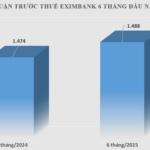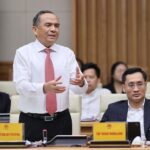According to the latest statistics from the State Bank of Vietnam (SBV), as of late July 2025, credit growth in the banking system reached 9.64% compared to the end of last year. As credit growth accelerates, the SBV has increased credit limits for many commercial banks, directing capital towards production and business activities, priority sectors, and key drivers of economic growth.
Bank lending to businesses amid reverse interest rate trends
In 2025, the SBV set a target of approximately 16% credit growth for the entire system to boost economic development while maintaining macroeconomic stability and controlling inflation.
To achieve this ambitious credit growth target, the SBV has implemented a series of credit programs, including lending for the construction of social housing and worker accommodation, as well as the renovation and reconstruction of old apartment buildings under Resolution 33/NQ-CP (with a current scale of VND 145,000 billion).
A VND 500,000 billion credit program has been established for infrastructure and digital technology investments in key national projects in the fields of transportation, electricity, and digital technology. Lending to the agriculture, forestry, and fisheries sector has also been increased to VND 100,000 billion.
According to Vietnam Industry and Trade Bank (VietinBank)’s report, several commercial banks have achieved credit growth rates higher than the industry average, including VietinBank with a 10.3% increase, Vietnam Technological and Commercial Joint Stock Bank (Techcombank) with 10.6%, Military Bank (MB) with 12.5%, and HDBank with an impressive 18.2% growth.
At a recent conference to review the first six months and deploy tasks for the second half of 2025, Mr. Pham Toan Vuong, General Director of the Vietnam Bank for Agriculture and Rural Development (Agribank), shared that Agribank’s credit balance exceeded VND 1,850,000 billion, marking a 7.6% increase compared to the beginning of the year.
“Agribank has proactively implemented 13 credit programs and products worth VND 400,000 billion to boost credit growth from the beginning of the year. We have also expanded the scope and scale of our credit programs for the agriculture, forestry, and fisheries sector to VND 20,000 billion,” Mr. Vuong stated.
Notably, despite the recent upward trend in deposit interest rates, lending rates have remained stable and even decreased.
SBV Deputy Governor Pham Thanh Ha affirmed that in the first half of 2025, the regulatory body maintained the stability of policy rates, enabling credit institutions to access low-cost capital from the SBV and subsequently support the economy.
Lending rates have continued to show a downward trend. The average lending rate for new transactions of commercial banks currently stands at 6.29%/year, a decrease of 0.64 percentage points compared to the end of last year.

The banking system’s credit growth reached 9.64% in the first seven months, injecting capital into businesses and contributing to economic growth. Image: Lam Giang
Businesses breathe a sigh of relief
As of the end of July, credit growth in the system reached 9.64%, the highest in recent years, injecting approximately VND 1,550,000 billion into the economy. In this context, many enterprises shared that accessing capital from commercial banks has become more accessible.
Mr. Nguyen Cong Tin, Director of Bologna Commercial Services Co., Ltd., operating in the agricultural sector, revealed that recently, several banks have proactively reached out and offered preferential loan packages with interest rates ranging from 8% to 10% per annum. These rates are lower than before.
According to Mr. Tin, if borrowing rates decrease further, his company will consider taking out loans to invest in production and business activities, such as upgrading factories, expanding raw material sources, cultivating new crops, and developing infrastructure to create momentum for the following year.
Mr. Le Hong Duc, founder of OneAds Digital Co., Ltd., shared that his company is currently utilizing bank loans for its operations. He is considering additional borrowing to expand its scale, particularly in investing in software systems to enhance the quality of services provided to customers. However, he remains hesitant due to the current market stagnation.
“If credit capital is available at more comfortable interest rates, it will undoubtedly boost market vibrancy and foster the development of enterprises,” Mr. Duc asserted.
Numerous businesses shared that, in addition to bank capital, there are government support policies for the agricultural sector, including non-refundable grants and zero-interest loans. However, accessing these funds is challenging due to a lack of information. Mr. Nguyen Cong Tin suggested the need for a channel to guide businesses on these supportive funds and the procedures to access them.
From another perspective, Mr. Dinh Hong Ky, Vice Chairman of the Ho Chi Minh City Business Association (HUBA), pointed out that the challenges faced by some enterprises, especially small and medium-sized enterprises, do not stem from difficulties in accessing credit but rather from a decrease in export orders and consumer market demand. “While it is beneficial to have a strong flow of credit into the economy, it is essential to direct and channel this capital towards priority areas such as technology, green credit, and social housing to foster sustainable economic development,” emphasized Mr. Dinh Hong Ky.
Mr. Nguyen Xuan Thanh, Dean of the Fulbright School of Public Policy and Management, suggested that from now until the end of the year, the SBV should maintain the current interest rate level. If there is pressure to increase interest rates, especially in the interbank market, the regulator could inject liquidity into the system through open market operations, issuing bills, or other financial instruments.
Proposals for unsecured business loans
In the 2025 Business Confidence Report recently published by the Private Economic Research and Development Board (Board IV), enterprises proposed several solutions to enhance access to credit.
These proposals included unsecured loans with low-interest rates based on financial statements and business performance. They also suggested providing small loans of VND 100-200 million to small businesses with a good tax payment history, starting from the second year of operation. Additionally, they recommended the immediate removal of bad debts from the National Credit Information Center (CIC) system for businesses and individuals who have fully settled their debts, enabling them to access new loans with appropriate collateral and facilitating their continued growth and development.
The Bank’s Endeavor to Lower Interest Rates
The Central Bank, in a bid to heed the Government and Prime Minister’s directive on enhancing measures to reduce interest rates, convened a meeting with the credit institution system on August 4, 2025. The primary focus of this gathering was to discuss strategies for stabilizing deposit rates and reducing lending rates.
“Unlocking Economic Growth: Vice Premier Advocates for Higher Credit Limits for Well-Performing Banks.”
“Regarding the credit growth cap, or ‘room’, as Deputy Prime Minister Ho Duc Phoc stated, this tool remains a vital lever in the short term for managing the economy. Adjusting this credit room is essential in the current context. Well-performing banks should be given more room to extend credit and boost the economy with much-needed capital.”
The Unexpected Twist in Mortgage Interest Rates
Amidst the upward trajectory of deposit interest rates, a surprising move by several banks has been to announce a further reduction in home loan interest rates.










































